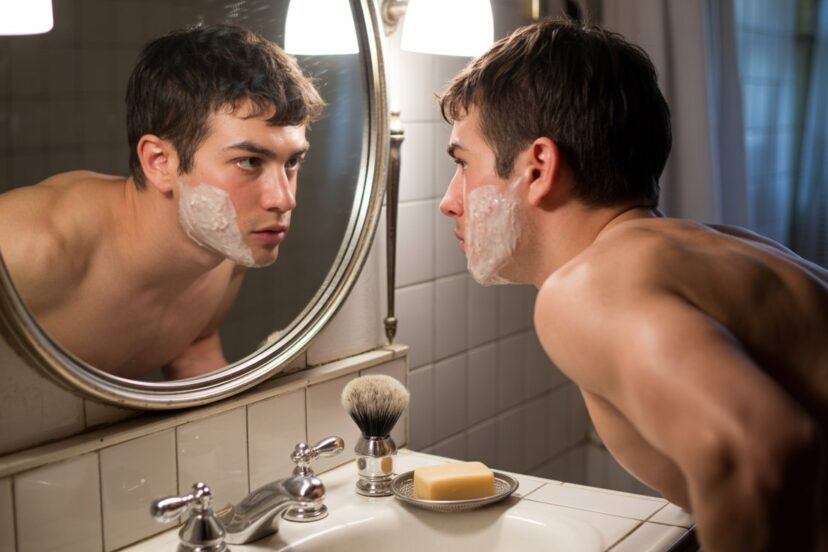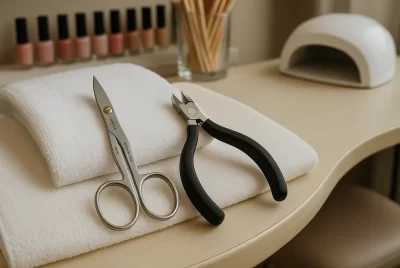How to Shave with Acne or Sensitive Skin Without Irritation
Post Disclaimer
*We may earn a commission for purchases made using our links. Please see our disclosure to learn more.
The mirror reflects back a familiar dilemma: the need to shave meets the reality of sensitive, acne-prone skin. Every stroke of the razor feels like navigating a minefield of potential irritation, razor burn, and breakouts. The morning routine that should be simple becomes a source of anxiety, wondering if today’s shave will leave behind angry red bumps or worsen existing blemishes.
This struggle affects millions of people who deal with the dual challenge of maintaining a clean-shaven appearance while managing sensitive or acne-prone skin. The good news is that with the right approach, techniques, and products, achieving a smooth, irritation-free shave is entirely possible, even for the most sensitive skin types.
“The key to shaving sensitive skin isn’t avoiding the razor—it’s understanding how to work with your skin’s unique needs. When you treat your skin gently, it responds with less irritation and better healing.”
– American Academy of Dermatology Guidelines
Key Takeaways
- Preparation is crucial: Proper pre-shave preparation can prevent 80% of shaving irritation
- Choose the right tools: Safety razors and quality shaving creams make a significant difference
- Technique matters: Gentle, short strokes with proper angle prevent skin damage
- Post-shave care: Immediate aftercare determines how your skin recovers
- Consistency pays off: Regular, gentle shaving is better than infrequent aggressive sessions
Recommended Products for Sensitive Skin Shaving
1. Gillette SkinGuard Sensitive Razor
The Gillette SkinGuard Razor is specially designed for men with sensitive skin, razor bumps, and acne. With its unique SkinGuard positioned between the blades, this razor minimizes blade contact to reduce irritation and help protect skin prone to breakouts. The lubrication before and after the blades ensures a smooth glide, while the precision trimmer on the back allows for easy styling in hard-to-reach areas. Perfect for those who struggle to shave with acne, this razor delivers comfort without sacrificing performance.
- Gentle Design: Reduces irritation for acne-prone and sensitive skin.
- Lubrication: Provides added glide for a smoother shave.
- Precision Trimmer: Ideal for shaping facial hair in tricky spots.
- Less Close Shave: Prioritizes comfort over ultra-close results.
- Limited Blade Count: Only 2 blades, less aggressive than multi-blade razors.
- Handle Compatibility: Only fits SkinGuard handles.
If you struggle to shave with acne, the Gillette SkinGuard Razor offers a skin-friendly solution that protects your face while delivering a smooth, comfortable shave. Unlike traditional razors, the SkinGuard features a protective bar between the blades, minimizing direct contact with sensitive or acne-prone skin. This design reduces the risk of cuts, razor bumps, and irritation—common issues when shaving over breakouts. With lubrication strips before and after the blades, the SkinGuard glides effortlessly, helping you achieve a cleaner look without aggravating your skin. For anyone looking to safely shave with acne, this razor is a top choice for both comfort and effectiveness.
2. Cremo Original Shave Cream
Cremo Barber Grade Original Shaving Cream is your go-to solution for an ultra-slick, irritation-free shave. Designed with advanced molecules, it creates a frictionless surface for your razor to glide effortlessly, delivering a close, comfortable shave without nicks or razor burn. Its paraben-free formula suits all skin types, making it a versatile choice for anyone seeking a professional-grade shave at home. The refreshing original scent adds a clean, invigorating finish to your grooming routine. With a 90-day supply in each bottle, Cremo ensures long-lasting value and superior performance that elevates your daily shave.
- Astonishing slickness: Provides an exceptionally smooth surface for a close shave.
- Value for money: A single 6 oz bottle lasts up to 90 days.
- Fights irritation: Reduces razor burn, nicks, and cuts effectively.
- Minimal lather: May not foam as much as traditional shaving creams.
- Requires precise application: Too much or too little can affect performance.
- Limited scent variety: Fewer options compared to competitors.
If you’re looking to shave with acne while minimizing irritation and discomfort, Cremo Original Shave Cream is an excellent choice. Its astonishingly slick formula allows razors to glide smoothly over sensitive or acne-prone skin, reducing the risk of nicks, cuts, and razor burn. Unlike traditional foams, Cremo’s rich cream cushions the skin without clogging pores, making it ideal for those dealing with breakouts. With a fresh, clean scent and long-lasting performance, Cremo ensures a gentle, close shave—helping you look your best without aggravating your skin.
3. Proraso Pre-Shave Cream for Sensitive Skin
The Proraso Pre-Shave Conditioning Cream is crafted for men with sensitive skin, featuring soothing ingredients like oatmeal and green tea. Designed to soften facial hair and protect the skin before shaving, it creates the perfect base for a smooth, irritation-free shave. This cruelty-free, Italian-made cream prepares your skin by reducing razor drag and helping to prevent razor burn, making it an ideal choice for those with delicate or acne-prone skin.
- Soothes Sensitive Skin: Oatmeal and green tea calm irritation.
- Prepares Skin for Shaving: Softens hair and reduces razor drag.
- Cruelty-Free Formula: Ethical grooming without compromise.
- Lime Scent: May not suit every fragrance preference.
- Additional Step: Requires extra time in grooming routine.
- Not a Standalone: Needs to be used with shaving cream or soap.
For men who struggle to shave with acne, proper skin preparation is key—and Proraso Pre-Shave Conditioning Cream offers the perfect solution. Enriched with oatmeal and green tea, this sensitive skin formula softens beard hair while creating a protective barrier that reduces razor friction and helps prevent irritation. By using Proraso as a pre-shave step, those with acne-prone skin can minimize redness, razor burn, and discomfort, making each shave smoother and more comfortable. Gentle, cruelty-free, and refreshing, this classic Italian formula is a trusted choice for sensitive shavers.
4. Thayers Witch Hazel Toner (Unscented)
Experience gentle, alcohol-free skincare with THAYERS Unscented Witch Hazel Facial Toner—a dermatologist-tested formula designed to soothe, tone, and hydrate your skin. Enriched with organic witch hazel and aloe vera, this vegan, cruelty-free toner helps balance pH levels, minimize pores, and maintain the skin’s moisture barrier for a naturally refreshed and healthier complexion. Perfect for all skin types, this versatile toner not only preps the skin for makeup but also calms irritation from shaving, waxing, sunburns, and bug bites.
- Alcohol-Free Formula: Gently tones and hydrates without drying out the skin.
- Multipurpose Use: Ideal for soothing after shaving, prepping for makeup, and calming irritation.
- Natural Ingredients: Made with organic witch hazel and aloe vera for a clean, refreshing experience.
- Mild Scent Variation: Some users notice a slight natural scent despite being unscented.
- May Not Suit All Skin Needs: Those with extremely oily or acne-prone skin might prefer a more targeted formula.
- Packaging May Vary: Some users find bottle variations slightly different from previous purchases.
Formulated without alcohol, this toner hydrates the skin while reducing redness, calming inflammation, and helping to tighten pores—key steps in preventing breakouts after shaving. With natural ingredients like organic witch hazel and aloe vera, it balances your skin’s pH without causing dryness or irritation. Ideal for acne-prone and sensitive skin, this dermatologist-recommended toner is perfect for soothing razor burn, leaving your skin calm, refreshed, and cared for after every shave.
Understanding Sensitive and Acne-Prone Skin
Sensitive skin reacts more intensely to external stimuli, including the friction and pressure of shaving. When combined with acne-prone skin, the challenge intensifies because existing blemishes create additional areas of vulnerability. The skin’s protective barrier is often compromised, making it more susceptible to irritation, infection, and inflammation.
Acne-prone skin typically produces excess oil, which can clog pores and create an environment where bacteria thrive. Traditional shaving approaches often strip away natural oils, causing the skin to overcompensate by producing even more oil, creating a frustrating cycle of breakouts and irritation.
The Science Behind Gentle Shaving
Understanding why irritation occurs helps in preventing it. When a razor blade cuts through hair, it also scrapes away the top layer of skin cells. For sensitive skin, this process can trigger an inflammatory response, leading to redness, bumps, and discomfort. Acne-prone skin faces the additional challenge of bacteria being pushed deeper into pores or spread across the skin’s surface.
The goal of gentle shaving is to minimize this trauma while still achieving effective hair removal. This requires a multi-step approach that prepares the skin, uses appropriate tools and techniques, and provides proper aftercare.
Pre-Shave Preparation: The Foundation of Success
Timing Your Shave
The best time to shave is after a warm shower when your skin is clean and hair follicles are softened. The steam and warm water help open pores and make hair more pliable, reducing the force needed to cut through it.
Cleansing Protocol
Start with a gentle, non-comedogenic cleanser to remove oil, dirt, and bacteria from the skin’s surface. Avoid harsh scrubs or products with alcohol, which can further irritate sensitive skin. Pat the skin dry with a clean towel, leaving it slightly damp to maintain moisture.
Pre-Shave Treatment
Apply a pre-shave oil or cream designed for sensitive skin. These products create a protective barrier between the razor and skin while providing additional lubrication. Look for ingredients like jojoba oil, vitamin E, or chamomile, which have soothing properties.
Mastering the Technique
Choosing the Right Razor
Single-blade safety razors often work better for sensitive skin than multi-blade cartridges. Multiple blades can cause more irritation by making multiple passes with each stroke. If you prefer cartridge razors, choose ones specifically designed for sensitive skin with fewer blades and protective guards.
The Perfect Shave Angle
Hold the razor at a 30-degree angle to your skin. This angle provides the most efficient cut while minimizing skin contact. Pressing too hard or using the wrong angle increases the risk of nicks, cuts, and irritation.
Shaving Direction Strategy
Always start by shaving with the grain (in the direction of hair growth). This reduces the pulling and tugging that can irritate sensitive skin. If you need a closer shave, you can carefully make a second pass across the grain, but avoid shaving against the grain, which significantly increases irritation risk.
Stroke Technique
Use short, gentle strokes rather than long passes. This gives you better control and reduces the chance of catching and irritating blemishes. Rinse the razor frequently to remove hair and shaving cream buildup, which can cause dragging.
Navigating Around Acne
Working Around Active Breakouts
When you encounter active blemishes, approach them with extra caution. Stretch the skin gently to create a flat surface, and use very light pressure. Consider using a precision trimmer or electric razor around severely inflamed areas to avoid opening lesions.
Preventing Bacterial Spread
Clean your razor blade frequently during shaving to prevent transferring bacteria from one area to another. Consider using separate, clean towels for drying your face and hands to maintain hygiene.
Post-Shave Care: Sealing the Success
Immediate Aftercare
Rinse your face with cool water to close pores and remove any remaining shaving cream. Pat dry with a clean towel—never rub, as this can irritate freshly shaved skin.
Moisturizing Strategy
Apply a gentle, fragrance-free moisturizer while your skin is still slightly damp. This helps lock in moisture and creates a protective barrier. Look for non-comedogenic formulas that won’t clog pores.
Treating Irritation
If you notice any irritation, apply a small amount of aloe vera gel or a product containing niacinamide, which helps reduce inflammation. Avoid products with alcohol, menthol, or strong fragrances that can further irritate sensitive skin.
Common Challenges and Solutions
Razor Burn Prevention
Razor burn occurs when the skin becomes irritated from too much friction or pressure. Prevent it by ensuring adequate lubrication, using light pressure, and not shaving too frequently. If razor burn occurs, treat it with cool compresses and anti-inflammatory ingredients.
Ingrown Hair Management
Ingrown hairs are common in people with sensitive skin. Prevent them by exfoliating gently 1-2 times per week with a mild chemical exfoliant like salicylic acid. Never pick or squeeze ingrown hairs, as this can lead to infection and scarring.
Dealing with Breakouts
If shaving seems to worsen acne, consider adjusting your routine. You might need to shave less frequently, change your shaving cream, or incorporate acne-fighting ingredients into your post-shave routine. Products containing benzoyl peroxide or salicylic acid can help, but introduce them gradually to avoid over-irritation.
Building a Sustainable Routine
Frequency Considerations
Many people with sensitive skin find that daily shaving actually reduces irritation compared to shaving every few days. When hair is longer, it requires more force to cut, increasing the risk of pulling and irritation. However, if your skin is particularly sensitive, you might need to shave every other day.
Seasonal Adjustments
Your skin’s needs change with the seasons. In winter, you might need richer moisturizers and more frequent pre-shave treatments. Summer heat and humidity might require lighter products and more frequent cleansing.
Product Rotation
Consider having different products for different skin conditions. On days when your skin is particularly sensitive or you have active breakouts, use gentler products or consider skipping shaving altogether.
Long-Term Skin Health
Monitoring Progress
Keep track of how your skin responds to different products and techniques. What works for others might not work for you, so pay attention to your skin’s signals and adjust accordingly.
Professional Guidance
If you continue to experience significant irritation or worsening acne despite following proper techniques, consider consulting a dermatologist. They can provide personalized advice and recommend prescription treatments if necessary.
Alternative Options
Remember that traditional wet shaving isn’t the only option. Electric razors, trimmer settings, or even professional laser hair removal might be better long-term solutions for severely sensitive skin.
Conclusion
Shaving with acne or sensitive skin doesn’t have to be a daily struggle. Success lies in understanding your skin’s unique needs, using the right products and techniques, and being patient with the process. The key is consistency—gentle, regular care produces better results than sporadic, aggressive treatments.
Remember that everyone’s skin is different, and what works for one person might not work for another. Don’t be discouraged if it takes time to find the perfect routine. With patience and the right approach, you can achieve a comfortable, irritation-free shave that leaves your skin looking and feeling healthy.
The journey to mastering gentle shaving is one of self-discovery and patience. Each successful shave builds confidence and proves that sensitive skin doesn’t have to limit your grooming goals. Start with the basics, be consistent, and gradually refine your technique as you learn what works best for your unique skin.
Frequently Asked Questions
Q: How often should I shave if I have sensitive, acne-prone skin?
A: Most people with sensitive skin find that daily shaving or every other day works best. Longer intervals between shaves can make hair coarser and require more pressure to cut, increasing irritation. Start with every other day and adjust based on your skin’s response.
Q: Can I use the same razor blade multiple times with sensitive skin?
A: Yes, but replace blades more frequently than you might with normal skin. Dull blades require more pressure and can cause more irritation. For sensitive skin, consider changing single blades after 3-5 shaves or cartridges after 5-7 shaves, depending on your hair thickness and shaving frequency.
Q: Should I use hot or cold water when shaving sensitive skin?
A: Use warm (not hot) water for preparation and shaving, then finish with cool water. Warm water softens hair and opens pores, making shaving easier. Cool water afterward helps close pores and reduces inflammation. Avoid very hot water, which can increase skin sensitivity.
Q: What ingredients should I avoid in shaving products for sensitive skin?
A: Avoid products containing alcohol, menthol, eucalyptus, strong fragrances, and harsh sulfates. These ingredients can increase irritation and dryness. Instead, look for gentle, fragrance-free formulas with soothing ingredients like aloe vera, chamomile, or oat extract.
Q: Is it normal for my skin to be slightly red after shaving, even with proper technique?
A: Mild, temporary redness immediately after shaving can be normal, especially for very sensitive skin. However, if redness persists for more than an hour, is accompanied by burning or stinging, or gets worse over time, you may need to adjust your technique or products. Persistent irritation isn’t normal and should be addressed.
















